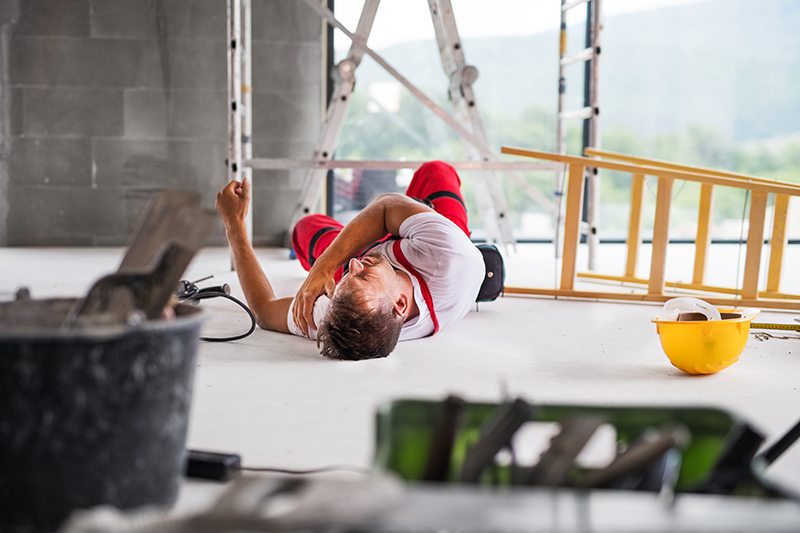
5 Ways to Prevent a Slip-and-Fall Injury
As the number-one reason for ER visits, slip-and-fall accidents are especially common in the workplace. The resulting injuries are also the leading reason for missed workdays and workers’ compensation claims. Here are five prevention strategies.
Virtually everyone has experienced an accidental fall at some point, whether it involved slipping on a slick floor, tripping over an object, or making a misstep on an uneven surface. Even a seemingly minor slip-and-fall incident can result in injuries like:
- Cuts and bruises
- Bone fractures
- Joint sprains
- Joint dislocation
- Muscle strain
- Disc herniation
- Concussion
Accidental falls are the number-one reason for emergency room visits. While they can happen anywhere, slip-and-fall accidents are especially common in the workplace; they’re also the leading reason for missed workdays and workers’ compensation claims.
Luckily, most slip-and-fall accidents are also preventable. As board-certified orthopedists who specialize in workers’ comp injuries and related services, our expert team at Orthopedic Center of Palm Beach County in Atlantis, Boynton Beach, and Wellington, Florida, is ready to help.
Here, we explore five effective employer- and employee-driven strategies for avoiding these common workplace injuries.
1. Maintain good housekeeping
A slip-free workplace begins with good housekeeping, and good housekeeping is an ongoing process that’s part of every worker’s daily routine and performance. Simply put, when an organization’s facilities are clean and well organized, it’s a strong indication that their safety program is effective as well.
Certain workers may be assigned to specific daily housekeeping tasks, but everyone has a role to play in keeping walkways, storerooms, and service areas clutter-free and easy to navigate.
While housekeeping specifics are unique to each workplace, general practices mean knowing what needs to be done both as you work and after work — and knowing what a particular work area should look like when you’re done.
2. Address all slippery surfaces
Wherever the ground is slick or slippery, feet are more likely to lose traction and slide off balance. Slippery walking surfaces are responsible for a substantial number of slip-and-fall injuries in the workplace, many of which happen because of liquid spills or wet weather.
Any walking surface — both indoor and out — can become hazardous when wet, including food prep areas, areas with hard flooring, sidewalks, and parking lots. Indoor flooring tends to be the most treacherous when it’s slippery, however, making it vitally important to clean up spills and tracked-in moisture from rainy weather as soon as possible.
Other indoor control measures to prevent slip-and-fall injuries include using non-slip, moisture-absorbing floor mats at entryways, placing non-slip mats in food prep areas, and displaying “wet floor” signs until slippery areas have been addressed.
3. Keep all areas well-illuminated
One slip-and-fall hazard that’s frequently overlooked is lighting. Insufficient illumination in the workplace is associated with increased accidents and injuries, including slip-and-fall as well as trip-and-fall accidents. Simply put, it’s easier to navigate safely — and notice potential hazards — in well-lit spaces.
It’s especially important to maintain proper lighting in spaces like staircases, walkways, hallways, ramps, kitchens, bathrooms, basements, construction areas, and dock areas. In addition, the areas around light switches should always be kept clear and accessible.
4. Always wear non-slip footwear
Shoe choice is an essential part of workplace safety and slip-and-fall prevention. In fact, wearing shoes with non-slip outsoles and good traction is one of the best ways to reduce your risk of slipping and falling on the job.
Some employers may only advise against wearing shoes that can increase your risk of getting injured on the job, such as sandals, open-toed shoes, canvas tennis shoes, and high heels. In other cases, employers may create an explicit shoe policy that aims to reduce slip-and-fall injuries, telling you exactly what kind of footwear is acceptable at work.
No matter where your workplace formally stands on the shoe safety spectrum, be sure to choose footwear with high-traction outsoles and excellent grip.
5. Skip shortcuts and take your time
Whether you’ve been in the same job for years or you only recently mastered a relatively new position, it can be easy to slip into autopilot mode when you know what you’re doing at work. Unfortunately, slip-and-fall injuries are more likely to happen when you’re not fully paying attention.
Being distracted or in a hurry, taking shortcuts, or tackling multiple physical tasks at once are common factors in many on-the-job injuries, as is looking at your cell phone instead of watching where you’re going, carrying objects that obstruct your vision, and walking too fast or running.
On-the-job safety doesn’t have to be difficult, and we’re here to offer expert support. Give us a call today to schedule a visit at your nearest Orthopedic Center of Palm Beach County office, or click online to schedule a visit anytime.





